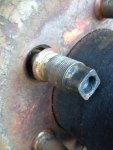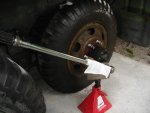**Sigh** I should leave this one alone, but I guess I'm a glutton for punishment. I actually had to do some historical research on this long ago because I had to deal with conflicting answers from the factory manuals about a cylinder head fastener torque, and wanted to know what was right. I'd read lots of issues of Hot Rod and Car Craft in my formative years, so I knew what they said, but I didn't know how to actually do the engineering and come up with the right answer from scratch (to weed out the good numbers from the bad in the factory manuals).
First, I asked my dad, who is a degreed mechanical engineer with a specialty in aircraft powerplant design. He mentioned the whole elastic modulus thing, yield strain, and preloading, which I knew about, but had never worked with much, as my engineering training was all on nonferrous materials, most of which have really funky characteristics in some use cases and are seldom preloaded. A little light reading about ferrous alloy tensile strengths, hardnesses, and cut or rolled threads and I was pretty close.
Then a brief gander at the Machinery handbook and the SAE handbook, and there you go. In my case, the hard part was tracking down what alloys the original materials were. Everything after that was pretty simple calculation.
The short answer is that fastener torque is always an indirect measurement: you're not measuring the preload (pre-strain, really) of the fastener (which is what you care about), you're measuring the force required to turn the fastener on its threads, which is an abstraction related to fastener stretch, but depending on:
1) the coefficients of friction between the moving and nonmoving parts (you can have multiple of these depending on where there's lubricant)
2) the thread pitch
3) the surface area of sliding contact (again, divided up into different areas if you have different coefficients of friction)
Almost nobody bothers to calculate this stuff from scratch - there's always a handy table. The tables are really quite good as long as you know what alloy and hardness are used for the fastener and the fastened material. And if somebody really, really cares, or it's a special part, or both, they'll find some way to put the specified fastener on a bench and measure actual stretch with a micrometer and the specified lubrication regimen and use THAT to set the fastener torque specification in the manual.
So what should you do? 99+% of the time, the answer is "whatever the manual tells you to do." So if you're working on a Meritor system on an OTR semi trailer, you do what Meritor says to do. End of discussion. It doesn't matter if you learned a different way on the farm, or if that's not what the manual for your '65 Ford Fairlane said to do. If you don't know what the manual says, then, as we say in the IT biz: 'get out of my cube and go RTFM.'
So what about the other <1% of cases where you don't have a manual (Pre WWII hardware, one-off specials, stuff like that)? Lots of the time you can consult period documentation that talks generically about hardware a lot like yours and get a magic number and method from that. The closer the documentation is to your specific lump of hardware, the more trustworthy the numbers within will be. So if you have, say a prewar Zundapp, and all you have is the manual for a prewar BMW of similar age, then you can probably trust the torque specs as long as thread pitch and materials (joined and fastener) are similar. Lots of times there's a standard table, as with US aviation airframe hardware. But if you're working on aviation hardware, you're an A&P and you already knew that, right?
And what if you don't have any manual at all, or you (as I did) have multiple manuals for your hardware telling you different things, and you know it's not a generic fastener application as seen in the Machinery Handbook? Well, then you get to play engineer and figure it out. Sometimes people writing manuals make mistakes. Sometimes the factory gets desperate and does stupid things with the specs in successive years to try to make a problem go away (that's what happened in my particular example).
I have seen tables equating torques between oiled and dry threads a couple of times in my life. They're tricky: you don't know how many times the threads have been buffed down by fasteners after they were cut/rolled, etc. One thing is always true: if the torque was spec'd for dry threads and you're oiling them, you're overtightening. If the specs are for oiled threads, your fastener won't be tight (stretched) enough if tightened dry.
I saw a statistic somewhere once that something like 90% of all fastener failures are due to overtightening. 'enough plus a little bit more' is very seldom the right answer. Remember that when worrying if the wheels are going to fall off your truck. Guess-a-torque is seldom the right answer, and if you have to guess, it's better to undertighten than overtighten almost all the time. Do note, though, that torque specs usually have a tolerance range, not a single number. Always tighten to the middle of the range - that copes with errors in your equipment or method.
For wheel lug nuts/bolts/studs, I've seen manuals that specified oiling the lug threads, the threads and the lug cone face (for conical lugs), or neither. Some say not to reuse a fastener, usually because it's tightened past its yield point and won't behave the same way if used a second time.
So, as far as I am concerned: there is no one right answer to this question because the engineers who designed the hardware didn't do it the same way every time. You're never going to find one right answer that fits everything. Quit trying. And RTFM.
And for the curious, the answer in my particular case was oiled threads and the torque from the earliest manual, which was 30-35 lb-ft.





